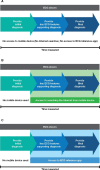Utility of mobile learning in Electrocardiography
- PMID: 36712390
- PMCID: PMC9707875
- DOI: 10.1093/ehjdh/ztab027
Utility of mobile learning in Electrocardiography
Abstract
Aims: Mobile learning is attributed to the acquisition of knowledge derived from accessing information on a mobile device. Although increasingly implemented in medical education, research on its utility in Electrocardiography remains sparse. In this study, we explored the effect of mobile learning on the accuracy of electrocardiogram (ECG) analysis and interpretation.
Methods and results: The study comprised 181 participants (77 fourth- and 69 sixth-year medical students, and 35 residents). Participants were randomized to analyse ECGs with a mobile learning strategy [either searching the Internet or using an ECG reference application (app)] or not. For each ECG, they provided their initial diagnosis, key supporting features, and final diagnosis consecutively. Two weeks later, they analysed the same ECGs, without access to any mobile device. ECG interpretation was more accurate when participants used the ECG app (56%), as compared to searching the Internet (50.3%) or neither (43.5%, P = 0.001). Importantly, mobile learning supported participants in revising their initial incorrect ECG diagnosis (ECG app 18.7%, Internet search 13.6%, no mobile device 8.4%, P < 0.001). However, whilst this was true for students, there was no significant difference amongst residents. Internet searches were only useful if participants identified the correct ECG features. The app was beneficial when participants searched by ECG features, but not by diagnosis. Using the ECG reference app required less time than searching the Internet (7:44 ± 4:13 vs. 9:14 ± 4:34, P < 0.001). Mobile learning gains were not sustained after 2 weeks.
Conclusion: Whilst mobile learning contributes to increased ECG diagnostic accuracy, the benefits were not sustained over time.
Keywords: App; ECG; Electrocardiography; Internet; Medical education; Mobile learning.
© The Author(s) 2021. Published by Oxford University Press on behalf of the European Society of Cardiology.
Figures







References
-
- Chan T, Sennik S, Zaki A, Trotter B.. Studying with the cloud: the use of online Web-based resources to augment a traditional study group format. CJEM 2015;17:192–195. - PubMed
-
- Roberts DH, Newman LR, Schwartzstein RM.. Twelve tips for facilitating Millennials' learning. Med Teach 2012;34:274–278. - PubMed
-
- Hopkins L, Hampton BS, Abbott JF, Buery-Joyner SD, Craig LB, Dalrymple JL, Forstein DA, Graziano SC, McKenzie ML, Pradham A, Wolf A, Page-Ramsey SM.. To the point: medical education, technology, and the millennial learner. Am J Obstet Gynecol 2018;218:188–192. - PubMed
-
- Traxler J. Defining, discussing and evaluating mobile learning: the moving finger writes and having writ. Int Rev Res Open Distributed Learning 2007;8:1–12.
-
- Briz-Ponce L, Juanes-Mendez JA, Garcia-Penalvo FJ, Pereira A.. Effects of mobile learning in medical education: a counterfactual evaluation. J Med Syst 2016;40:136. - PubMed
LinkOut - more resources
Full Text Sources
